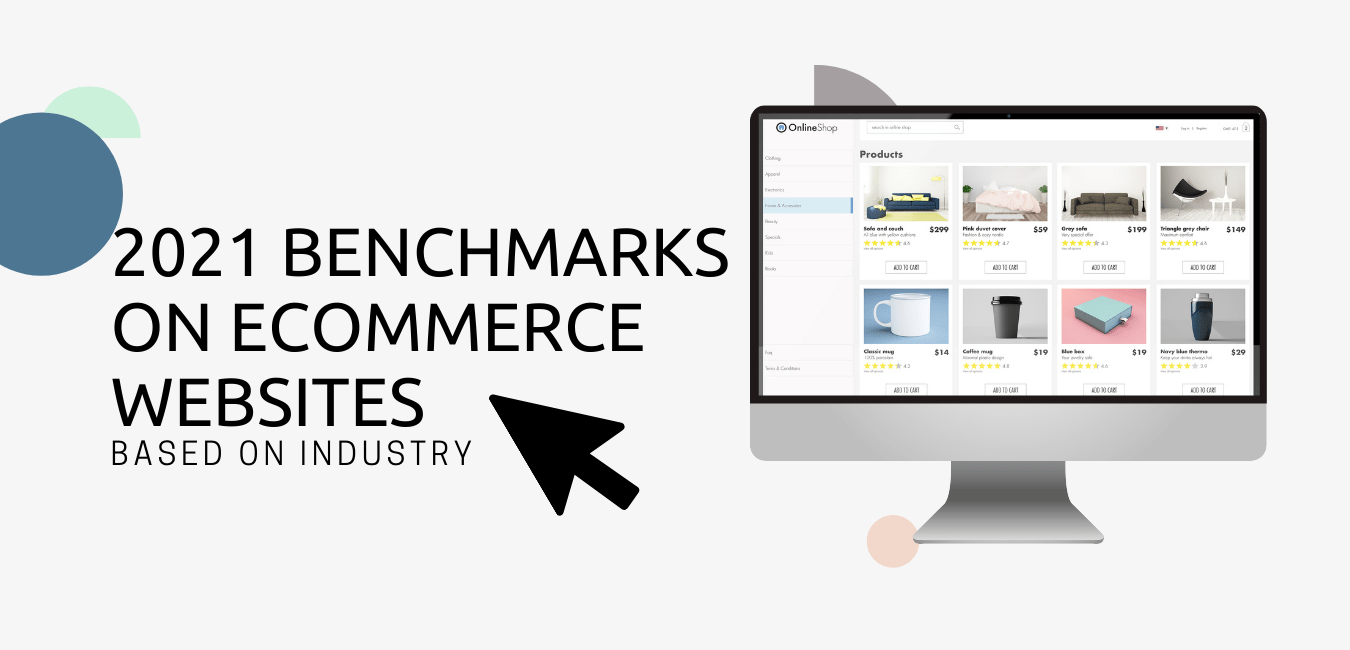As you will know, conversion rates are often used as a KPI to review the effectiveness of e-commerce sites which is why we’re providing you with the benchmarks you need to watch out for this 2021.
Naturally, all site managers and owners want to know, “how do our conversion rates compare?” In this post, I have compiled different free industry sources focusing on retail e-commerce conversion.
Here’s what you need to watch out for:

Traffic Source
Traffic sources (by visitors)
- Organic: 43%
- Paid search: 18%
- Direct: 20%
- Email: 4%
- Social: 5%
- Display: 1%
- Referral: 7%
- Other: 3%
Why should you care?
Compare this with your own traffic sources to see which traffic where you might be underperforming.
Traffic sources (by revenue)
- Organic: 38%
- Paid search: 18%
- Direct: 19%
- Email: 4%
- Social: 2%
- Display: 0%
- Referral: 17%
- Other: 2%
Why should you care?
This can be an indicator that the effectiveness of your investments is off. You could be attracting a lot of organic traffic, but get no sales from it. This means that you’re missing critical links in addressing the buyer process.
Device type (by revenue)
- Mobile: 26% (vs 26% in 2017)
- Desktop: 56% (vs 61%)
- Tablet: 12% (vs 13%)
Why should you care?
Segment your own revenue by device type to see what your breakdown looks like.
On-site engagement metrics
- Average pages per session: 5
- Average session duration: 3m01s
- Average bounce rate: 41%
- Average page load time: 6.8s
- Average server response time: 0.97s
Why should you care?
These numbers will vary widely depending on your industry and website. But a general rule is that more engagement with your site is better.
Transaction path length
- For the visitors that have converted, how many sessions did it take before they converted?
- 1 session: 40%
- 2 sessions: 60%
- 3 sessions: 70%
- 5 sessions: 81%
- 12+ sessions: 100%
Why should you care?
Many store owners expect to make a sale the first time someone visits their site. These benchmarks show that most of your revenue will actually come from visitors that come back to your site.
Ecommerce Average Order Value
Average order value (by traffic source)
- Direct: $134.87
- Email: $100.80
- Search: $121.69
- Social: $98.66
- Unknown: $141.58
Why should you care?
Your average order value (AOV) depends on the type of products you sell. But solid businesses bring in solid revenue. And building an ecommerce empire on $150 orders is a lot easier than doing it on $10 orders. If your order value is too, low, you might need new products or cross/upsell more effectively.
Average Order Value (by store performance)
- Top 25% stores: $102.93
- 25-50%: $97.73
- 50-75%: $88.31
- Bottom 25%: $74.73
Why should you care?
These numbers illustrate what great stores do compared to the average ones.
Conversion Rate (by device type)
- Desktop: 3.83% (vs 4.05% in Q2 2017)
- Tablet: 3.84% (vs 3.59%)
- Smartphone: 2.03% (vs 1.7%)
Why should you care?
Mobile visitors convert at almost half the rate of desktop visitors. That’s a fact and these benchmarks illustrate it. Continue to innovate and improve your mobile experience.
Add-to-Cart Rates (by device type)
- Desktop: 10.93% (vs 11.36% in Q2 2017)
- Tablet: 12.20% (vs 11.19%)
- Smartphone: 9.78% (vs 9.04%)
Why should you care?
If your visitors don’t buy, have a look at the add-to-cart rates for your store. Are people adding product to their baskets? You might need to configure extra ecommerce analytics to be bale to track this metric.
Cart Abandonment Rate
The average shopping cart abandonment rate is 69.89%%.
Why should you care?
It can be frustrating to see visitors add things to their carts, but then abandon the checkout later.
But most of these visitors were never going to buy anyway. About 58% of all those abandoned carts claim it’s because they were “just browsing”. Many use the shopping cart as a save for later list.
That doesn’t mean that there is nothing you can do about the remaining 40%. If you score below this benchmark, take a look how you could improve your checkout experience to generate more sales.
Annual Ecommerce growth rate
Stores with an annual revenue between $0-1 million have an annual growth rate of 137%.
Why should you care?
Keeping track of this metric is a pretty advanced thing to do. But if you know how fast the best stores in your industry are growing, it will help you to set realistic growth targets for your own store.
New versus repeat orders
Top 25% companies
- Month 2: 20% of revenue comes from repeat customers.
- Month 36 (3 years): revenue from repeat customers starts taking over revenue from new customers.
Bottom 75% companies
- Month 2: 10% of revenue comes from repeat customers.
- Month 36: revenue from repeat customers equals revenue from new customers.
Why should you care?
Solid businesses are build on repeat orders. It’s cheaper to get your existing customers to buy again, and if that revenue reaches scale, your store really grows leaps and bounds.
Average Gross Margins in Ecommerce
Average gross margins sit in the 30-40% range.
Why should you care?
The average gross margin for your industry might be very different. But one interesting remark from this study is that the gross margin increases with the size of the business increases.
Ecommerce Customer Acquisition Cost (repeat customers)
Customer acquisition cost for repeat customers is between ⅛ and ⅓ of the original cost.
Why should you care?
You need to spend big money to get customers into your world. But getting them to buy again will cost you a lot less.
Google Ads benchmarks
Google Ads Clickthrough Rate (by network)
- Search Network: 2.69%
- DisplayNetwork: 0.52%
Why should you care?
I use this CTRs as a minimum threshold for my Google Ads campaigns.
Average Google Ads Clickthrough Rate (by percentile)
- 25th percentile: 1.91%
- 50th percentile: 3.23%
- 75th percentile: 5.58%
- 90th percentile: +9.5%
Why should you care?
Rather than aiming for the average, these numbers show what great advertisers are doing.
Average Google Ads Cost Per Click (by network)
- Search Network: $1.16
- Display Network: $0.45
Why should you care?
The actual cost per click might be different for your industry. But these averages provide an easy way to make predications and rough estimates.
Average Google Ads Conversion Rates for Ecommerce
- Search: 2.81%
- Display: 0.59%
ALSO READ: 2021 Performance Benchmarks for Healthcare in Digital Marketing
Google Shopping benchmarks
Google Shopping Revenue share (by device)
- Desktop: 48%
- Mobile: 42%
- Tablet: 10%
Why should you care?
Mobile keeps rising and gaining in importance and ROAS. So you need a good plan on how to capture mobile traffic. The days of -100% bid adjustments are definitely over.
Average Google Shopping Cost per click (by device)
- Desktop: $0.85 (vs $0.78 in 2016)
- Mobile: $0.33 (vs $0.33 )
- Tablet: $0.6 (vs $0.74)
Why should you care?
If you are working with a limited budget, explore what you can do by focusing more on mobile traffic for your Google Shopping campaigns.
Average Google Shopping Conversion Rate per Device
- Mobile: 1.49%
- Desktop: 2.36%
- Tablet: 2.11%
Average Google Shopping Bounce Rate per Device
- Mobile: 74%
- Desktop: 63%
- Tablet: 70%
Average Google Shopping Pages per session per Device
- Mobile: 2.53 pages
- Desktop: 3.55 pages
- Tablet: 2.98 pages
Why should you care?
The higher bounce rate has a very similar explanation to the lower conversion rate. Mobile makes it harder to browse through the offering.
YouTube Ads benchmarks
- CPV: $0.026
- View rate: 31.9%
- CPM: $3.53
- CPC: $0.49
- CTR: 0.65%
Bing Ads benchmarks
- Average Click-Through Rate: 3.06%
- Average Cost per Click (CPC): $1.24
- Average Conversion Rate: 2.65%
- Average Cost per Action (CPA): $30.25
Facebook Ads benchmarks
- Average Click-Through Rate: 1.59%
- Average Cost per Click (CPC): $0.70
- Average Conversion Rate: 3.26%
- Average Cost per Action (CPA): $21.47
Why should you care?
These numbers can help you get an idea how effective your Facebook ad campaigns are and what kind of numbers you should be setting as your targets.
Email marketing benchmarks
- Average email open rate: 15.66%
- Click rate: 2.07%
- Unsubscribe rate: 0.24%
Average revenue per recipient
- Annual revenue below $100k: $0.06
- $100k – $1M: $0.07
- $1M – $10M: $0.11
- $10M+: $0.21
Why should you care?
Email is one of the only assets you truly own in your business. And as you can see, a solid email marketing program can account for a steady stream of revenue.
Use this information to your advantage
My goal with these conversion rate and cost per conversion benchmarks is to give you the competitive insights you need to get a leg up on the other businesses in your space across the major online advertising channels. The data is pretty simple, but it can be powerful all the same.

Source: https://www.storegrowers.com/ecommerce-metrics-benchmarks/#cvr
Subscribe to my YouTube channel: Casey Ordoña
